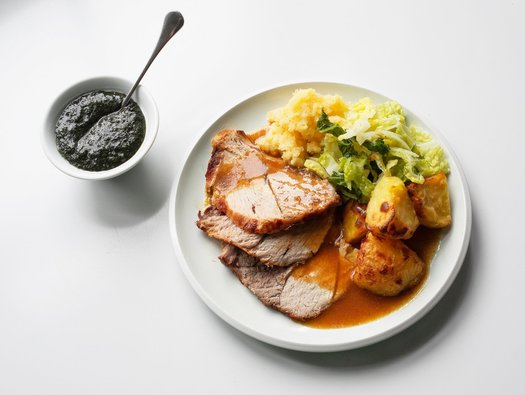Roast lamb

A roast dinner that’s low in potassium, phosphate, and salt. It's also high in protein so makes a great hearty post-dialysis meal.

A roast dinner that’s low in potassium, phosphate, and salt. It's also high in protein so makes a great hearty post-dialysis meal.
1.5kg boneless leg of lamb (95g of cooked lamb per person)
Small bunch of rosemary, in small sprigs, divided into 2 halves
1 clove garlic, peeled and sliced
1 onion, sliced
4 medium potatoes (approx. 500g), peeled and cut into four
2 tablespoons olive oil
250g swede, peeled and chopped into chunks
40g unsalted butter
250g spring greens, shredded or 250g carrots peeled and chopped
Cracked black pepper
15g plain flour
25ml low-salt lamb stock
Mint sauce
Pre-heat the oven to 200°C/ 180°C fan/ gas mark 6. Make incisions into the lamb at an angle to a depth of about 5cm. Stuff one half of the rosemary sprigs and all the slices of garlic into the incisions. Put onion slices into the bottom of the roasting tin and sit the lamb on top. Season with black pepper and rub over a little of the olive oil. Place in the oven for 20 minutes, then lower the oven to 180°C/ 160°C fan/ gas mark 4, and cook for another 20 minutes per 500g (for a 1.5kg joint – 1 hour), depending on how you like your meat cooked.
Put the potatoes into a pan of cold water and bring it to the boil. Cook until the potatoes are soft, then drain in a colander. Shake the potatoes to rough the edges up a little. Cover with a tea towel to trap any remaining steam.
Heat another roasting tin with olive oil in the oven for 5 minutes, then remove and add the par-boiled potatoes, turning them to coat in oil. Add the rosemary and return to the oven for 45 minutes.
Add the swede to a saucepan of cold water and boil until soft, then drain and return the swede to the pan. Add the unsalted butter and black pepper to taste and mash, then keep warm until serving. 10 minutes before serving, add the shredded spring greens or chopped carrots to a saucepan of water and boil until cooked. Once cooked through, drain and discard the water.
Remove the lamb from the oven, take out of the roasting tray and drain any juices back into the tray. Set the lamb to one side and allow to rest for 15 minutes. Put the roasting tray over a low heat on the hob and stir in the flour. Cook until the juices have absorbed. Add the stock slowly, stirring until it thickens to make the gravy. Strain.
Serve your lamb, potatoes and vegetables on warm plates, pour the gravy over the top and serve with the mint sauce.
The potatoes are the main source of carbohydrate in this recipe, and the value has been provided for those who have been trained in insulin adjustment.
This recipe is low in potassium, despite the use of some high potassium foods, such as potatoes, lamb, and vegetables. This is because the quantities have been kept to a minimum, therefore please ensure you follow the quantities for all the ingredients and the serving sizes.
This recipe is also low in phosphate, however it still contains phosphate, provided by the lamb, therefore, if you are prescribed a phosphate binder you should take as directed.
This recipe is high in protein, which makes it suitable for those advised to eat more protein, particularly those receiving dialysis.
Use gluten-free flour for the gravy.
Best eaten straight away. Leftover lamb can be stored in the fridge for a later meal for up to 3 days.
The whole family will enjoy tucking into our hearty, filling meals on a chilly winter's evening.
You can enjoy a wide variety of delicious and healthy food when you are living with kidney disease. All Kidney Kitchen recipes are analysed and approved by kidney dietitians. Search through our kidney-friendly recipes or filter them by category below.
By giving us your email address, you're giving us permission to send you the latest news from Kidney Care UK. Further information about how we protect and use your personal data is available in our Privacy policy. If you would like to change the way we communicate with you at any time please email [email protected]. You can unsubscribe at any time by using the link at the bottom of every email we send.